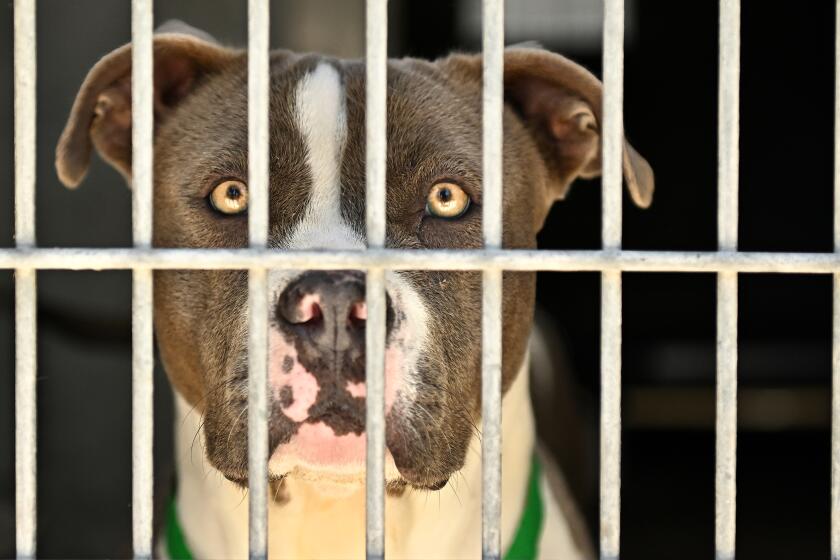Keeping Bzzzy
- Share via
LAKE VIEW TERRACE — With a smoke machine in hand, Bill Lewis removes the cover of a 10-inch-deep wooden box--and a swarm of 16,000 bees comes buzzing out.
The key to avoiding stings, he says, is to not make sudden moves that would anger the bees. That’s just one of the tricks he has picked up over the past 25 years since he began beekeeping as a Boy Scout in Wisconsin.
“I’m addicted to bees--the smells, the sounds,” Lewis said. “I don’t think my life would be the same without them.”
About 10 years ago, Lewis gave up a career as an aerospace engineer at McDonnell Douglas Corp. for a job as a maintenance supervisor at Middle Ranch, a private boarding stable off Little Tujunga Canyon Road.
Lewis found a few abandoned bee colonies at a neighboring ranch and decided to adopt them. What began as a hobby has turned into a profitable part-time business--”Bill’s Bees”--which generated about $20,000 last year in sales of bee products including honey, beeswax candles, soaps and bee pollen used in health foods, he said.
“I took a 50% pay cut, but my quality of life is good, better than before,” said Lewis, 43, of his decision to abandon the corporate world. “I really enjoy living out here. It’s healthier for the mind and body.”
He attributes much of that improved lifestyle to his beloved bees--which he tends to for a few hours each evening after his regular workday ends.
Lewis has about 8 million bees under his care, organized in 100 “colonies” of about 80,000 bees each. Each colony consists of five 17-by-19-inch wooden boxes arrayed in a bee yard a few hundred feet from his front door.
The bees produce about 30,000 pounds of honey annually, which Lewis sells mostly at farmers markets locally and by mail order across the country.
“The honey is marvelous,” said Delene Harrison of North Hollywood, who said she buys about $100 worth of Lewis’ products every three to four months for herself and friends.
“I cook with it. I make soups, stews, glazes for meat. And I’ve even gotten some of my friends addicted to the honey and soaps,” she said.
Harvests 1,000 Pounds of Honey a Day
Lewis, who lives on the ranch with his wife, Liane, 38, and their two children, can harvest about 1,000 pounds of honey on a typical day.
He uses a smoke machine to clear the bees and remove the honeycombs, stored in wooden frames, from the boxes.
He takes the boxes containing the frames to his “honey house”--a converted steel storage container--and places them in an uncapper, a desk-size steel machine that removes the wax formations, or cappings, on the cells of the honeycomb to release the honey.
After the cappings are removed, the honeycombs are placed in a spinner, a cylindrical machine where the honey is further extracted. The honey is then placed in a settling tank, where wax and debris is removed. The honey is then ready to be bottled.
Lewis then places the honeycombs back in the boxes to be reused by the bees. The byproduct of honey, beeswax, is put in a wax melter, where it can be processed for use in soaps and candles.
In spring and summer Lewis does not feed the bees, letting them gather nectar from plants in bloom. In the winter, when most plants are dormant, he feeds them sugar water and pollen, checking on the colonies periodically to make sure all the hives have a queen.
Lewis buys bear-shaped containers from the Los Angeles Honey Co. and gets paper wrap for soaps and candles from retailers like Kmart and Target.
He and his wife make labels on his computer. “When the kids are asleep, we stick labels on the jars while watching Jay Leno,” said Lewis.
In addition to farmers markets, Lewis supplies other vendors in the area, who then sell it under their own labels.
Ramana Zaratanya, a Tujunga resident and owner of Shining Sun Nutrition, is one of those vendors. Zaratanya has bought bee pollen from Lewis for the last four years.
“It’s the best bee pollen I have ever come across,” said Zaratanya.
Pollen Popular in New Age Diets
Zaratanya, who operates his business from home, said bee pollen is used in New Age products and super-foods. He said bee pollen has the necessary vitamins, amino acids and proteins for the body. Bee pollen is blended in drinks and smoothies, sprinkled on fruit salad or eaten by the spoonful with milk or juice.
The vendor said the freshness and color of Lewis’ bee pollen make it exceptional.
“Maybe it’s the area,” Zaratanya said. “Such a wide, rural area, you never know where the bees go and what they take to their hives.”
He said he buys anywhere from $52 to $150 worth of Lewis’ bee pollen every month. Zaratanya purchases about 8 to 15 pounds and then resells it in 4- and 8-ounce containers under his Shining Sun Nutrition label.
Lewis’ first encounter with bees was in his native Wisconsin as a teenager. He needed a merit badge from the Boy Scouts, and an elderly friend introduced him to beekeeping. He says that from that moment on he’s been addicted to the hobby.
More to Read
Sign up for The Wild
We’ll help you find the best places to hike, bike and run, as well as the perfect silent spots for meditation and yoga.
You may occasionally receive promotional content from the Los Angeles Times.






